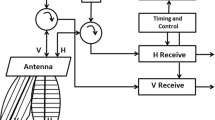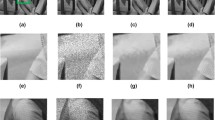Abstract
Significant employment of polarimetric synthetic aperture radar (SAR) is the classification of the Earth’s surface, which includes several processing algorithms, labelling, and representation options. This paper investigated the potential performance of the polarimetric reference function in SAR data processing to apply in coherent decomposition. The proposed methodology employed the simulated radar cross section of dihedral and trihedral corner reflector under a SAR geometry using physical optics (PO) and geometrical optics (GO) to produce the polarimetric reference function for azimuth compression in the processing of SAR data. The Pauli and the Krogager decompositions processed the compressed SAR data to investigate the effect and performance of the polarimetric reference function. The colour clustering results based on k-mean clustering algorithm could deliver more related scattering characteristic. The image pixel classification was strongly associated with the polarimetric reference function in processing step. These findings indicated that the obtained decomposition and clustering results could provide a better performance in visual impact and quantitative evaluation according to the decomposition term, as well as its physical interpretation.










Similar content being viewed by others
References
Curlander, J.C., McDonough, R.N.: Synthetic Aperture Radar: Systems and Signal Processing. Wiley, New York (1991)
Klausing, H., Holpp, W.: Radar mit realer und synthetischer Apertur: Konzeption und Realisierung. Oldenburg Verlag, Wien (2000)
Evans, D.L., Farr, T.G., van Zyl, J.J., Zebker, H.A.: Radar polarimetry: analysis tools and applications. IEEE Geosci. Remote Sens. Lett. 26(6), 774–789 (1988)
Huynen, J.R.: Phenomenological Theory of Radar Targets. Drukkerij Bronder-offset, Rotterdam (1970)
Holm, W.A., Barnes, R.M.: On Radar Polarization Mixed State Decomposition Theorems. In: Proceedings of 1988 USA National Radar Conference 249–254 (1988)
Yang, J., Peng, Y.N., Yamaguchi, Y., Yamada, H.: On Huynen’s decomposition of a Kennaugh matrix. IEEE Geosci. Remote Sens. Lett. 3(3), 369–372 (2006)
Freeman, A., Durden, S.L.: A three-component scattering model for polarimetric SAR data. IEEE Trans. Geosci. Remote Sens. 36(3), 963–973 (1998)
Yamaguchi, Y., Moriyama, T., Ishido, M., Yamada, H.: Four-component scattering model for polarimetric SAR image decomposition. IEEE Trans. Geosci. Remote Sens. 43(8), 1699–1706 (2005)
Cloude, S.R., Pottier, E.: A review of target decomposition theorems in radar polarimetry. IEEE Trans. Geosci. Remote Sens. 34(2), 498–518 (1996)
van Zyl, J.J.: Unsupervised classification of scattering behavior using radar polarimetry data. IEEE Geosci. Remote Sens. Lett. 27(1), 36–45 (1989)
Lee, J.S., Pottier, E.: Polarimetric Radar Imaging: From Basics to Applications. CRC Press, Boca Raton, FL, USA (2009)
Krogager, E.: New decomposition of the radar target scattering matrix. Electron. Lett. 26(18), 1525–1527 (1990)
Chunhua, L., Wang, J., Shang, J., Huang, X., Liu, J., Huffman, T.: Sensitivity study of Radarsat-2 polarimetric SAR to crop height and fractional vegetation cover of corn and wheat. Int. J. Remote Sens. 39(5), 1475–1490 (2018)
Ren, B., Hou, B., Wen, Z., Xie, W., Jiao, L.: PolSAR image classification via multimodal sparse representation-based feature fusion. Int. J. Remote Sens. 39(22), 7861–7880 (2018)
Eini-Zinab, S., Maghsoudi, Y., Sayedain, S.A.: Assessing the performance of indicators resulting from three-component Freeman-Durden polarimetric SAR interferometry decomposition at P-and L-band in estimating tropical forest aboveground biomass. Int. J. Remote Sens. 41(2), 433–454 (2020)
Alberga, V., Krogager, E., Chandra, M., Wanielik, G.: Potential of coherent decompositions in SAR polarimetry and interferometry. In: Proceedings of 2004 IEEE International Geoscience and Remote Sensing Symposium (2004)
Noori S.S., Tahmoresnezhad, J.: Joint Distinct Subspace Learning and Unsupervised Transfer Classification for Visual Domain Adaptation. Signal, Image and Video Processing (2020)
Ma, J., Wan, H., Wang, J., Xia, H., Bai, C.: An Improved Scheme of Deep Dilated Feature Extraction on Pedestrian Detection. Signal, Image and Video Processing (2020)
Phruksahiran, N., Michanan, J., Petchatree, S., Chandra, M.: Improving SAR data processing with polarimetric reference functions in the range Doppler algorithm. Int. J. Remote Sens. 38(23), 6582–6598 (2017)
Horn, H.: The DLR airborne SAR project E-SAR. In: Proceedings of 1966 International Geoscience and Remote Sensing Symposium 249–254
Cumming, L.G., Wong, F.H.: Digital Processing of Synthetic Aperture Radar Data: Algorithms and Implementation. Artech House, Boston (2005)
Balanis, C.A.: Advanced Engineering Electromagnetics. Wiley, New York (1989)
Dybdal, R.B.: Radar cross section measurements. Proceedings of IEEE 75(4), 498–516 (1987)
Phruksahiran, N., Chandra, M.: Polarimetric radar cross section under SAR geometry. Adv. Radio Sci. 11, 277–282 (2013)
Griesser, T., Balanis, C.A.: Backscatter analysis of dihedral corner reflectors using physical optics and the physical theory of diffraction. IEEE Trans. Antennas Propag. 35(10), 1137–1147 (1987)
Acknowledgements
The authors would like to thank Prof. Dr. Madhukar Chandra of TU Chemnitz, and Prof. Dr.-Ing. Alberto Moraira of DLR, Germany, for providing the E-SAR data set from the EU Project AMPER for use in the study.
Author information
Authors and Affiliations
Corresponding author
Ethics declarations
Conflict of interest
No potential conflict of interest was reported by the authors.
Additional information
Publisher's Note
Springer Nature remains neutral with regard to jurisdictional claims in published maps and institutional affiliations.
Rights and permissions
About this article
Cite this article
Phruksahiran, N. Potential performance of polarimetric reference function of SAR data processing by coherent target decomposition. SIViP 15, 1021–1029 (2021). https://doi.org/10.1007/s11760-020-01827-9
Received:
Revised:
Accepted:
Published:
Issue Date:
DOI: https://doi.org/10.1007/s11760-020-01827-9




